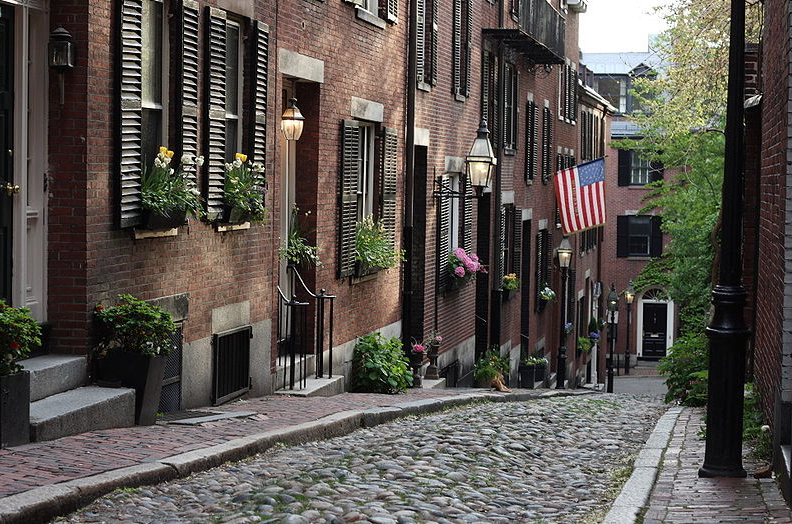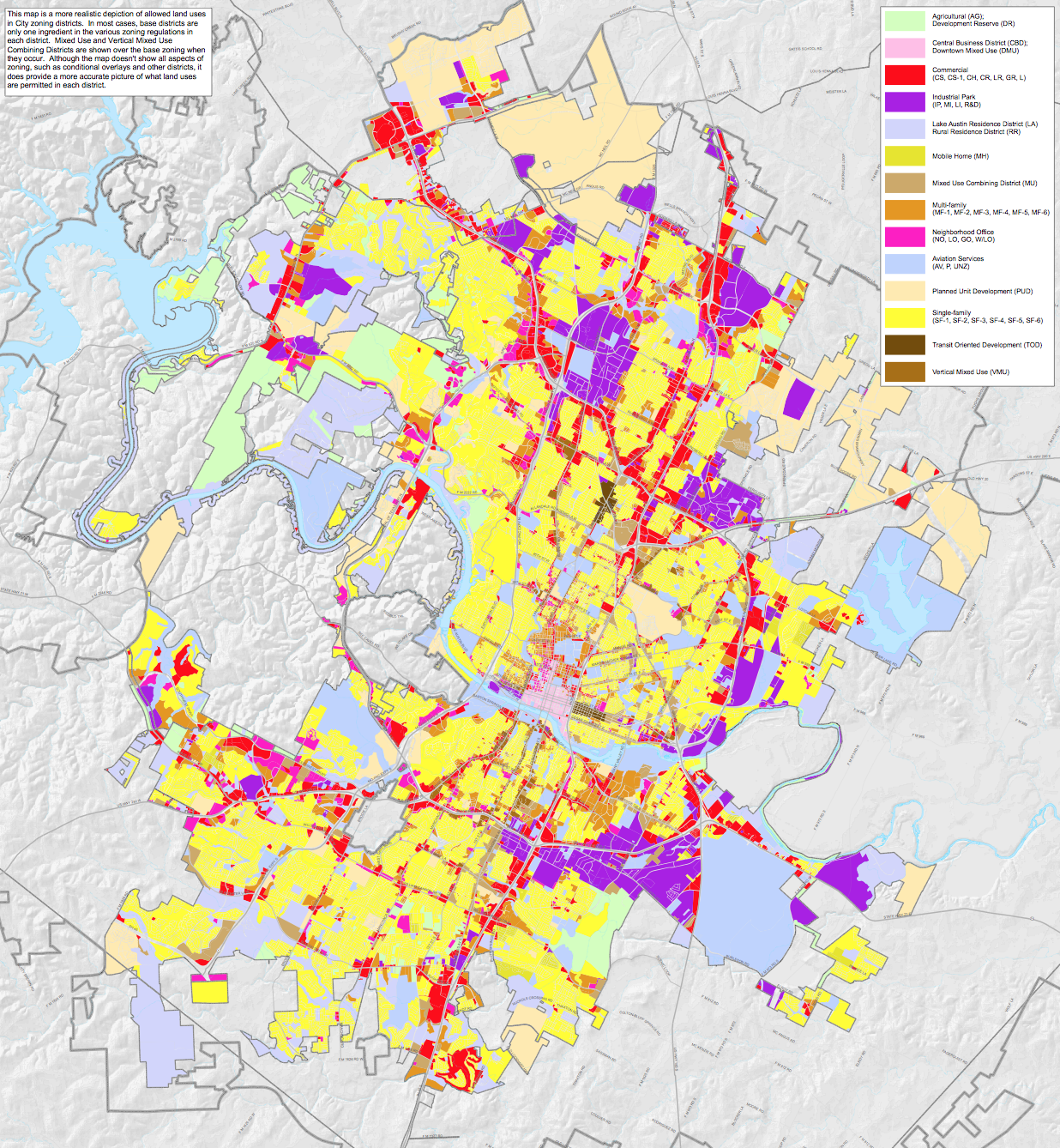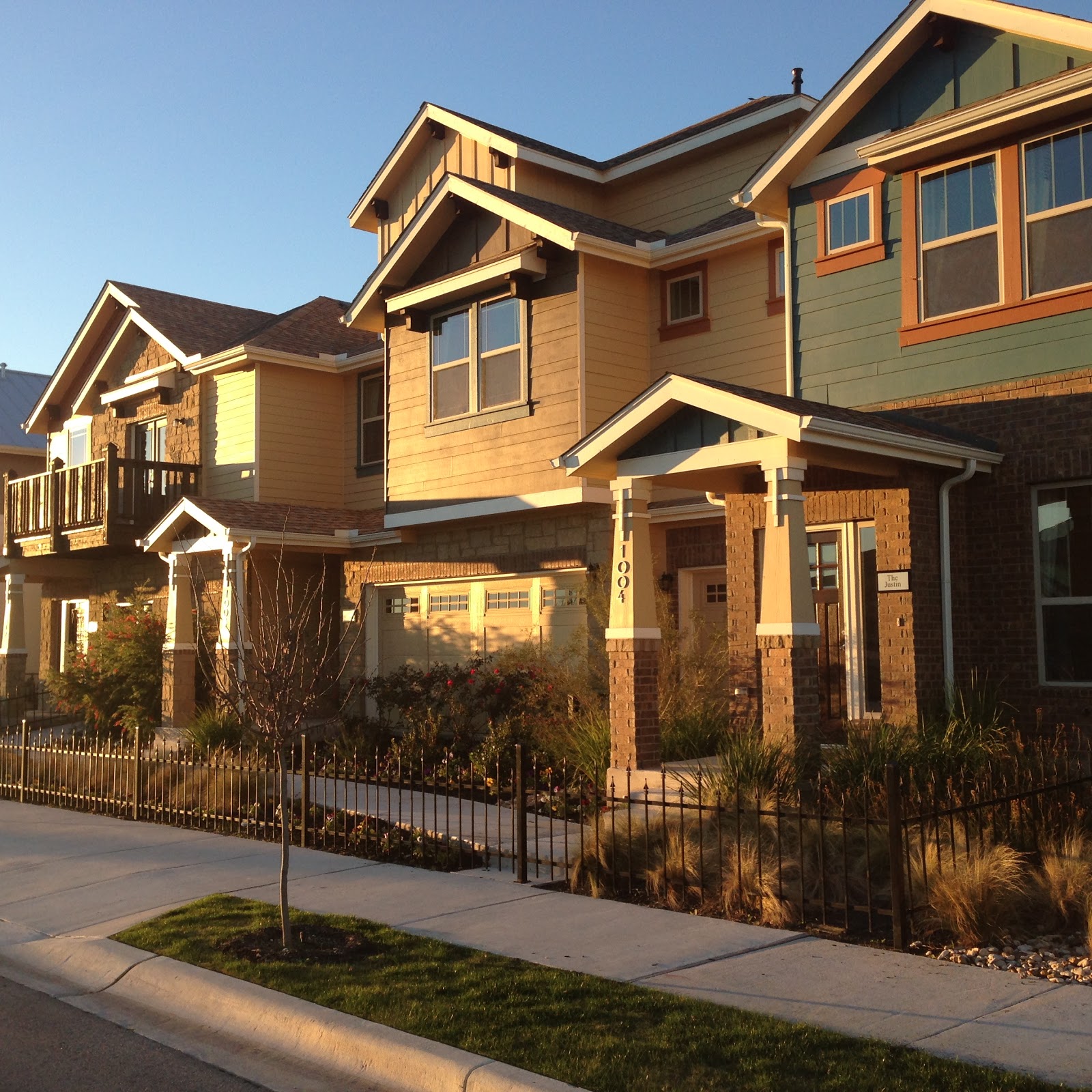In Part 1 of this series, guest blogger Mateo Barnstone discussed how row houses can help with affordability and why they might make a great deal of sense given growth pressures Austin is facing. Today he’ll dig deeper into how the land development code limits the availability of this housing type.
While there are indisputable cost savings to row houses (in a city with a big affordability problem, that is no small matter) and other potential advantages, there are, of course, other considerations that factor heavily in Austin developing land use policies. Many of the regulations contained within our Land Development Code exist specifically as a means of “preserving the character” of our neighborhoods. Take for example Subchapter F – the McMansion Ordinance. The stated goal of the McMansion Ordinance is to “minimize impact of new construction on older neighborhoods,” and the standards chosen specifically were adopted to “protect the character of Austin’s older neighborhoods by ensuring that new construction, remodels and additions are compatible in scale and bulk with existing neighborhoods.” [1]
When we seek to preserve the character of a place, we all understand the intention is to protect that place from getting worse – but it also prevents a place from evolving for the better. We can debate until our eyes roll to the back of our head about what qualities make one neighborhood better than another – but I defy anyone to look at these lovely neighborhoods below and tell me why they’re inherently flawed because of the extensive use of row houses:


 Dan’s linked post does a pretty great job of laying out the basic problem in Austin. SF-3 zoning is essentially a suburban code. The problem is that suburban code is the widely applied default zoning of our urban core.
Dan’s linked post does a pretty great job of laying out the basic problem in Austin. SF-3 zoning is essentially a suburban code. The problem is that suburban code is the widely applied default zoning of our urban core.
As a reminder – the following is a zoning map of Austin. Yellow indicates the single-family SF zoning:
 As you can see – the overwhelming predominant zoning in Austin is Single Family (SF). And the most common SF zoning is SF-3.
As you can see – the overwhelming predominant zoning in Austin is Single Family (SF). And the most common SF zoning is SF-3.
SF-3 prescribes:
| Minimum Lot Size | 5,750 sf |
| Minimum Lot Width | 50 ft |
| Maximum Units Per Lot | 1 |
| Maximum Impervious Cover | 45% |
| Maximum Height | 35 ft |
| Minimum Setbacks | |
| Front Yard | 25 ft |
| Street side yard | 15 ft |
| Interior side yard | 5 ft |
| Rear yard | 10 ft |
With a minimum lot width of 50 ft, large lot sizes and mandated sideyards we can quickly see why we don’t have a lot of row houses in Austin – they’re largely prohibited by code.
On top of that, there are parking requirements, various overlays including neighborhood plans and a whole additional layer of restrictions under the McMansion Ordinance which further regulates and limits development by establishing additional maximum development requirements, front and rear setbacks, setback planes (the so-called tents that create additional sloping setbacks), side wall articulations and other compatibility standards. So even if one were able to get the variances needed to construct a row house development they would, in most cases, be barred under the McMansion Ordinance.
McMansion specifically targets protecting central Austin neighborhoods, precisely where additional density makes the most sense and where lack of housing supply and options is quickly making these areas out of reach for all but our most fortunate denizens:
 So – where can you build row houses in Austin? The answer is not very many places.
So – where can you build row houses in Austin? The answer is not very many places.
You could do so on downtown lots zoned CBD or DMU but market forces would make this highly unlikely to occur in all but extremely limited circumstances. SF-4B does not appear to have a maximum number of units and no side yard setback requirement so it might be theoretically possible. However, in discussing row houses and zoning with David Whitworth, he said that he’s never actually seen a SF-4B lot.* Row houses are also theoretically possible under neighborhood Mixed Use zoning. If you’re looking for where those might be – look very hard. They’re the light brown lots on the zoning map above.
There are two other zoning districts where row houses are possible: There is Traditional Neighborhood District (TND) and Transit Oriented Development (TOD). I’m not aware of any subdivision that has taken advantage of TND yet (if any reader is, please let us know in the comments). The TOD is limited to a handful of locations scattered about town. The furthest along appears to be Crestview which does have a few blocks of row houses.
The vast majority of row houses being built today in Central Austin are in Mueller. As a PUD, Mueller has special land use regulations and is specifically exempted from the McMansion Ordinance.
This is how the SF-3 stacks up against places in Austin where row houses are possible:
| SF-3 | TND/TOD | Mueller Row Houses** | |
|---|---|---|---|
| Minimum Lot Size | 5750 sf | 2000 sf | 1575 sf |
| Minimum Lot Width | 50 ft | 20ft (25 corner) | 16 ft / (25 corner) |
| Maximum Height | 35 ft | 35 ft | 40 ft/3 stories |
| Setbacks | |||
| Front | 25 ft | 5 ft | 10 ft |
| Street Side Yard | 15 ft | 10 ft | 5 ft |
| Interior Side Yard | 5 ft | 0 ft | 0 ft |
| Rear Yard | 10 ft | 10 ft | 5 ft |
| Max. Impervious Cover | 45% | 65% / 85% | 95% |
| Approximate Units/Acre | ~6 | ~20 | ~25 |
You can see how radical a change would be needed in our code to allow for these structures in our center city neighborhoods.


Including row homes in TODs and PUDs is a fine idea and they are indeed building a lot of them in Mueller. But these kinds of opportunities are few and far between. We can’t fix all of Austin’s affordability problems with PUDs like Mueller. As large a development as Mueller is, it’s only roughly a square mile and represents less than 1/2 of 1% of the land in the City of Austin. As a comparison, Austin has about 10 times that amount zoned for mobile homes.
If we’re going to address our affordability issues in a meaningful way we need to get more housing and more housing options into the yellow zones on that map – otherwise we’re just nibbling at the edges and paying lip-service to “compact and connected.”
What we can do is look to places like Crestview and Mueller as proof-of-concept. We know that row houses can be built in a way that allows for plenty of light, does not feel over crowded and can be done in a variety of pleasing architectural styles. Those places show that Missing Middle housing can blend in perfectly well with other housing types, including single family detached homes, and that the neighborhoods that allow for them will remain desirable, pleasant and lovable places.
One final thought – and it’s ridiculous to even have to make this point but shrill voices from those fearful of change force having to put these disclaimers – merely allowing for these structures to be built will not mean the automatic scraping of Austin’s central neighborhoods. A developer has to find a contiguous plot of land or assemble enough parcels together to develop a block of row houses. And the project has to be financeable, constructable and marketable – that’s not going to happen that much in central Austin. There’s a limited market for this product. Row homes are a great option for my family and I think that as people become more familiar with the advantages of row houses that many will be attracted to the cost savings and other advantages – but I recognize they’re not for everyone (just as single family detached homes are a great product for some, but not for everyone). If we permit enough variety of housing types then the market will determine what the right mix is over time and residents will have an abundance of of options to choose from.
Change is hard and requires careful thought. But Austin is under tremendous growth pressure. Our land development code makes many of the tools for attractive urban growth illegal and as a direct result forces sprawl. As David Whitworth pointed out to me, the City imposed SF-3 housing at a time when sprawl made a certain amount of sense: land was cheap, distances were short (made even shorter by the automobile), and traffic was light. I think everyone can agree that none of those conditions exist today.
My question is this: why are we clinging to a suburban code in our urban core? Is there a tangible reason, other than fear of change, that makes the row house worth making illegal to develop in the urban core where density makes the most sense and as a direct result force more sprawl on the periphery with all of its concomitant ills?
TL;DR – The City of Austin is engaged in the CodeNEXT re-write of our Land Development Code to align our land use regulations with Imagine Austin’s priority program 8 which calls for regulations that promote a compact and connected city. The row house is among the housing types that can help the city achieve the goals of Imagine Austin, can be built at a substantial discount to single family detached homes and thereby help address Austin’s affordability problems, efficiently utilizes available land, contributes to walkable communities and can help build a resilient tax base while still preserving high quality residential neighborhoods.
* The minimum site requirements for townhouses permitted in SF5 and SF6, the “Townhouse & Condominium Residence” codes, appears too large to build affordable row houses and seems to contemplate more of a detached city home.
**Actual lot widths offered at ~22.5ft appear to be a bit wider than minimum permitted under the PUD. The Mueller Design Book shows lot dimensions of 90 x 22.5 and 70 x 22.5. There are also 55 x 35 lots for live-work “shop homes”. See section 2.3.

Accurate thoughts here. Again, I have two tools (and only two tools) to lower the cost of housing: increasing the density (like rowhouses) and making the units smaller (rowhouses are typically smaller than single family homes). Limiting rowhouses (and condos, and apartments, etc.) ALL contribute greatly to a reduction in the supply of affordable housing. Any regulation that limits density does the same thing.
Secondarily, and just as important, by limiting density in our urban core (take the area you outlined as the McMansion Ordinance), while well intentioned, not only increases the cost of housing, it causes a deterioration in our transportation systems. The jobs are where they are. But, put in regulations that push housing in general “out” and more importanly, push “reasonably-priced” housing “out”, means we are causing more and more people to get on the major transportation corridors to try to get to work. Constructing a rowhouse project or a higher density apartment project or other dense project within a couple of blocks of a major job center is not only good for housing, it is a transportation improvement (taking people off the major transportation corridors).
Thanks Terry – again, great to get a builder’s perspective on this and definitely agree with your points about the transportation system which I did not address directly.
Its unfortunate that the LDC largely takes the two tools you mention (density and smaller units) out of the hands of the builders. I hope I’ve demonstrated in these posts how the zoning code directly impacts affordability. Seems to me that row houses (and other missing middle housing) solve a lot or problems at once: 1. They offer more affordable options; 2. They bring people closer to their desired destinations (thereby limiting congestion on our roads); and 3, they make our city more resilient by simultaneously boosting the tax base while reducing the liability incurred by spreading out roads, utilities and services over large distances. By permitting this missing middle housing we can do a lot to address our problems of affordability, traffic and health of the city while still being compatible with and respecting the character of our core neighborhoods.
When Crestview is finished, it will be around 200 townhomes/row homes and 100 single family homes. The row homes are larger than I’m accustomed to, and all the plans are larger than my 1400 sf detached house. But they are filling up pretty quickly.
As for SF-4B, I’m no zoning expert, but the only time I ever heard of it was as a “compromise” solution for the Korean Baptist Church property on Justin. Old Guard NIMBYs through it out there, but the developer didn’t bite. They claimed you could build townhouses on it, but I doubt they really wanted that if it came down to it.
Interesting that the ratio of row houses to single-family detached being sold in Crestview is about 2:1. I’ve heard many people question the viability of Missing Middle housing and that the market desires SF detached homes. Of course, survey preferences are somewhat meaningless especially when the market is telling us there is plenty of demand for this product. I haven’t seen too many row houses sitting on the market in Mueller (of course, I haven’t seen too many houses of any kind sitting on the market in Central Austin at all). What that tells me is that people are willing to make trade-offs (more affordable or living in a walkable area close to work but sacrifice a bit of yard) in real life that they aren’t making on surveys.
Regardless of what the market does or does not desire, it seems especially ludicrous to presume what the market wants and zone accordingly. If there’s truly no desire for Missing Middle housing types then the first few developers that try it an lose their shirts and will be the last.
Rather, I think this is another false attack on Missing Middle housing, and the real concern is that there is pent up demand for it and accommodating that demand will require making some changes to how we do things.
Is what we’re doing today working? I don’t think it is.
Mateo, I agree with what you say except for one thing: if developers overestimate demand for rowhouses, they aren’t going to lose their shirt, unless they make a Bull Creek-sized PUD of thousands. If these are reasonably sized developments, the worst that will happen is that they’ll just have to lower the price and somebody will decide to move in for a bit cheaper than anticipated, even if it isn’t their ideal home.
Perhaps the expression I used overstates the case. Nevertheless, the larger point I think stands – not many developers will attempt to build Missing Middle housing (such as row houses) if it turns out the market is really soft. Few want to go through the effort and risk of building something that has an iffy demand.
Yeah, completely agreed Mateo. Just saying: it isn’t even like the risk is so huge. We’re not going to be stuck with some albatross empty homes. Worst that happens is a few people lose a little money and we get some affordable housing.
They built thousands of row-houses and the world didn’t end. In fact, people loved them, and paid fairly decent money to live in them!
Houston built thousands of row-houses and the world didn’t end. In fact, people loved them, and paid fairly decent money to live in them!
Excellent summary of the barriers to creating a practical urban core in Austin. It seems that even PUDs like Mueller can’t really stem the rising tide of houses.
Their last change in 2009 to make zero lot-line homes (Garden Homes) resulted in a temporary filling of the affordability gap there – the price points between income-qualified and market rate housing.
The latest Mueller PUD changes promise yet smaller lot row homes and duplex units sold as condos. It’s like trying to keep up with the Red Queen. So if it’s a struggle in a PUD, it’s going to be a huge hurdle in the City.
Excellent summary of the barriers to creating a practical urban core in Austin. It seems that even PUDs like Mueller can’t really stem the rising tide of houses.
Their last change in 2009 to make zero lot-line homes (Garden Homes) resulted in a temporary filling of the affordability gap there – the price points between income-qualified and market rate housing.
The latest Mueller PUD changes promise yet smaller lot row homes and duplex units sold as condos. It’s like trying to keep up with the Red Queen. So if it’s a struggle in a PUD, it’s going to be a huge hurdle in the City.